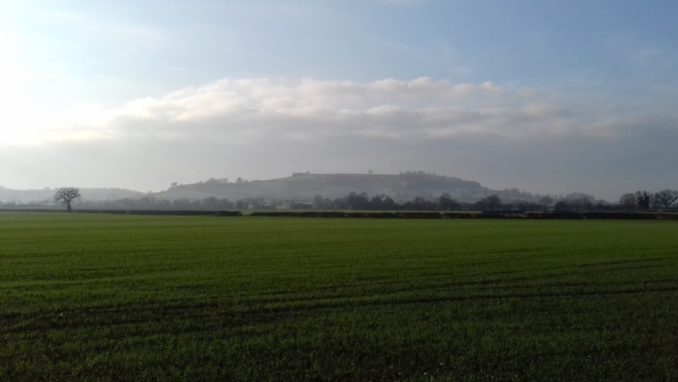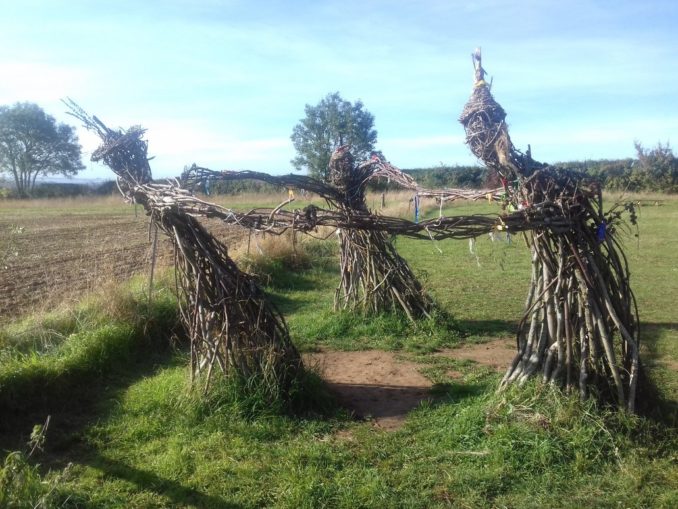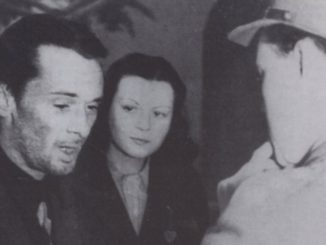
© Going Postal 2019
Meon Hill lies in the valley of the River Avon, on the border of Oxfordshire and Warwickshire. It is an outlier of the Cotswolds and, although it reaches only a modest 194m of elevation, it is a landmark in an otherwise gently undulating countryside. The top of Meon Hill is flat, but scored with ancient ditches and banks. Archaeology has revealed that it was the site of human occupation as far back as the Neolithic Era, when it was part of the religio-cultural complex that raised such enigmatic monuments as Silbury Hill, Stonehenge and the nearby Rollright Stones. What pagan rites were performed here we may never know, but it is a remote area and still a weird, wild landscape even now. Most especially so on a haywire Winter’s day, when sere leaves rattle in the hedgerows and trees stretch their bare limbs towards a dark and tumbling sky.
As night fell on the 14th February 1945 the corpse of an elderly local man, Charles Walton, was found on the eastern slope of Meon Hill. Three crushing blows had been delivered to his chest with a bill hook, each blow breaking a number of ribs, and on the third blow the weapon had been left embedded in Walton’s trachea. A pitchfork had been jammed through Walton’s neck as he lay on the ground, and this with such force that it later required two men to pull the tines from the earth. Walton had also been beaten about the head with his own walking stick, which was found ‘matted with blood and hair’ a few yards away from his body. The killer had ripped open Walton’s shirt and carved the shape of a cross into the man’s chest. It is said that Walton’s face was a mask of horror and anguish.
At the time of his death, Walton was seventy four years old. He had lived in Lower Quinton, the village that nestles under Meon Hill, all his life. He was not a sociable man, but was far from being disliked by his neighbours. Walton was a widower and shared his cottage with his niece, Edith Walton, who he had adopted thirty years previously after the death of her mother. Although troubled by rheumatism in his knees, Walton still worked as an agricultural labourer and had been employed for the last nine months by Alfred Potter, a local farmer.
Edith had arrived home at 6pm that evening and, finding Walton was not there, had become worried for his safety. Fearing the old man might have been taken unwell and be lying in the darkness unable to call for help, she called on her neighbour Harry Beasley to walk with her up the hill to find her uncle. First, though, they called at The Firs farm to alert Mr Potter. Potter said he had see her uncle a few hours earlier, cutting back hedges in an area of the hill known as Hillground, and offered to accompany them.
Thus it was, about half an hour later, that Walton’s body and the savagery of its mutilation lay revealed in the beam of Potter’s torch. Edith was so overcome by the horror of the sight that she began to scream piercingly, and Potter ordered Beasley to take her back to her cottage and to call the police. Potter stood guard alone over the gruesome remains until a police officer, PC Lomasney, arrived on the scene at 7.05 pm. Detective Superintendent Alec Spooner of Warwickshire CID was there by 9pm, and a technician from the West Midlands Forensic Laboratory by 11 pm. Walton’s body was finally removed at 1.30 am.
Warwickshire Police conducted some initial interviews and investigation, but soon realised they were out of their depth with this brutal and apparently senseless killing. On the 15th February Superintendent Spooner sent a telegram to the Metropolitan Police requesting help and on the 16th of February Scotland Yard duly obliged, sending their brightest and best: Chief Inspector Robert Fabian and his partner, Detective Sergeant Albert Webb.
Hardly anyone remembers Fabian these days, which is a pity. A tough but intelligent and scrupulous copper, he was also, by the standards of the day, what we would call ‘media savvy’. He first came to prominence in 1939, when he dismantled an IRA bomb in Piccadilly by cutting the gelignite to pieces with his pen knife. Thereafter the press followed his cases avidly, and Fabian became the first Celebrity Copper.
After his retirement in 1949, Fabian took up the position of crime feature writer for The Sunday News and Empire Chronicle newspaper. which in turn led to a successful career as an author and media personality. In 1956 the BBC commissioned a TV series entitled ‘Fabian of the Yard‘ based on Fabian’s books. Fabian’s laconic and gritty style translated well to television, and the series was a resounding success; it is arguable that it also paved the way for the ‘hard-boiled’ style of TV police shows such as Z-Cars and The Sweeney.

© Going Postal 2019
But all this lay very much in the future for Inspector Fabian as he and Sgt Webb climbed out of their unmarked Wolseley 18/85 police car, and sniffed the dank, chill air of a Warwickshire February evening.
With Fabian at the helm, the investigation moved up a gear. By the next morning, an Avro Anson photo-reconnaissance aircraft from nearby Long Marston airfield was circling Meon Hill and taking high resolution pictures of the murder scene. It had also been determined that Charles Walton’s pocket watch was missing from his body, although half his watch chain still remained intact. Fabian duly drafted in a platoon of Royal Engineers with mine detectors, who swept the area far and wide looking for the missing watch or anything else of interest. Neither activity accomplished anything of note, although it all made for good column inches and convinced the Brass back at the Yard that ‘something was being done’.
Fabian turned his attention to the pool of likely suspects, beginning with the trio who had first discovered the body. Edith Walton and Harry Beasley were quickly eliminated from the enquiry, but Alfred Potter was to remain a Person of Interest throughout the investigation. Potter was the last person to have admitted to seeing Walton alive, and also one of the people present at the discovery of his body. This alone would statistically make him the likely culprit.
There were also contradictions in Potter’s testimony. The post-mortem on Walton’s body had determined that he had died some time between 1pm and 2pm on the 14th of February. Potter’s accounts of his own activities from Noon to 1pm altered during subsequent interviews and left a suspicious gap between the time of him seeing Walton in the distance at around 12.15pm, and the time when he arrived back at The Firs at 12.40pm which was corroborated by his wife. “Potter is undoubtedly lying about his actions at this critical time,” Fabian noted in his report “but the reason for these lies can, for the present, only be a matter for conjecture.”
The investigation ground onward. Every inhabitant of Lower Quinton over the age of eleven was interviewed, some 500 people in all. The occupants of the nearby Long Marston POW camp also came under scrutiny. There were about a thousand of these, mainly Italians, Slavs and few Ukrainians and Germans. Security at the camp was lax, in common with British practice at the time, and on the day in question a dozen or so prisoners had left the camp and walked the few miles into Stratford-upon-Avon, some to see a film and some to see a play at the RSC theatre. There was a brief flurry of excitement when an Italian POW was found to have blood on his greatcoat, but forensic examination proved this to be animal blood – the man had been supplementing the monotonous camp diet by snaring rabbits.
Then events began to take a peculiar turn. One evening Fabian was walking the slopes of Meon Hill, when a large black dog ran by him and vanished into the twilight. A minute later Fabian saw one of the local children walking towards him. ‘Are you looking for your dog, son?’ Fabian asked the lad. ‘What dog?’ said the boy. ‘A big, black one. It ran off the other way.’ Fabian told him. The lad turned as white as a sheet and bolted off into the gloom, leaving Fabian nonplussed.
Spectral black dogs are deeply embedded in British legend and folklore. Known as Black Shuck in the Fens and East Anglia, as Barghest in York and as Moddey Dhu on the Isle of Man, to name just a very few of his local manifestations, he is a nocturnal spirit and his appearance is generally regarded as a portent of death. The belief goes at least as far back as the Anglo-Saxons and very probably much, much further. The belief seems also to have been prevalent in Lower Quinton at the time of Charles Walton’s murder, as we shall see.
The day after Fabian met the black dog on Meon Hill, a black dog was found hanged from a tree hard by the murder site. A few days after this, a police car ran over and killed yet another black dog just outside the village. Attempts to trace the owner failed. As this sequence of events became common knowledge, co-operation from the locals, which could have at best been described as grudging, ceased altogether. One evening Fabian and Webb popped into the College Arms pub in Lower Quinton for a couple of pints. As they walked in, the bar fell deathly silent until a voice from the back said ‘Walton’s dead. Leave it alone.’
Fabian, a city boy to the soles of his size twelve regulation issue boots, began to flounder. Anonymous letters flooded in, detailing witchcraft ceremonies and coven meetings on and around Meon Hill. Even Detective Superintendent Spooner seemed to credit the belief. He gave Fabian a book, Folklore and Superstitions in Warwickshire by J.H.Bloom, who had been a local vicar. In this was related the tale that in the last decades of the nineteenth century, a young Warwickshire plough boy had seen the Black Dog not once, but six times. The boy’s name was Charles Walton. As he handed Fabian the book, Spooner gave him ‘a strange smile’.

© Going Postal 2019
From here on, Fabian seems to have realised he would not solve the case of Walton’s slaying. He said of Alfred Potter, despite his proximity to the murder and the contradictions in his evidence, that there was “no real evidence to connect him with the murder itself, and no reasonable motive can be found for his committing it.” At the end of March, Fabian and Webb headed despondently back to London. Spooner kept things going as long as he could, but eventually resources were needed elsewhere and the case went cold. But for many years after, Spooner would visit Lower Quinton on the anniversary of the murder and spend an hour or so at the site of the killing. In time a tree that stood there became known locally as Spooner’s Oak.
As to the motive for the killing, it is still unclear. Witches were traditionally regarded as having the power to blight crops and kill cattle. The harvest of 1944 had been a notably poor one, and a heifer of Potter’s had died suddenly the day before Walton’s murder. The ritual elements of the killing, the cross carved into the body and the fixing of the corpse to the ground with the pitchfork were made great play with by newspapers, who dubbed it the ‘Witchcraft Murder’. The only other apparent reason for Walton’s savage death, the theft of his cheap tin pocket watch, is at least logical though a flimsy enough reason for hacking a man to death.
Although he never gave the Occult Theory of Walton’s murder any credence in his reports at the time, Fabian had this to say about the case in his memoirs:- “I advise anybody who is tempted at any time to venture into Black Magic, witchcraft, Shamanism – call it what you will – to remember Charles Walton and to think of his death, which was clearly the ghastly climax of a pagan rite. There is no stronger argument for keeping as far away as possible from the villains with their swords, incense and mumbo-jumbo. It is prudence on which your future peace of mind and even your life could depend.”
As somebody who has met more than one of the Hail, Satan! brand of Loon and Fruitloop in his time, I can tell you that this is very sound advice indeed.
One last thing remains for us to clear up: the missing pocket watch. In 1960 Walton’s cottage, 16 Lower Quinton, was undergoing refurbishment. Behind a loose brick in an outhouse, the builders found an old pocket watch which in every particular met the description of the one that had been taken from Walton’s still-warm corpse. Of course, it may have been a different watch entirely. But that would be quite a coincidence, don’t you think?
© Bobo 2018
Audio file



